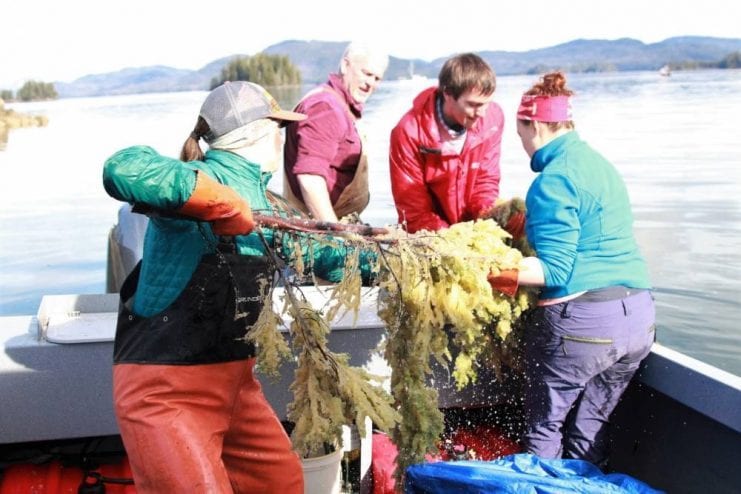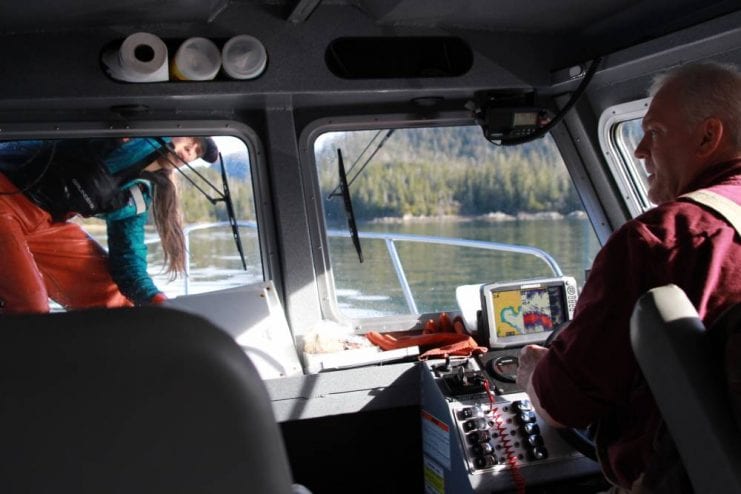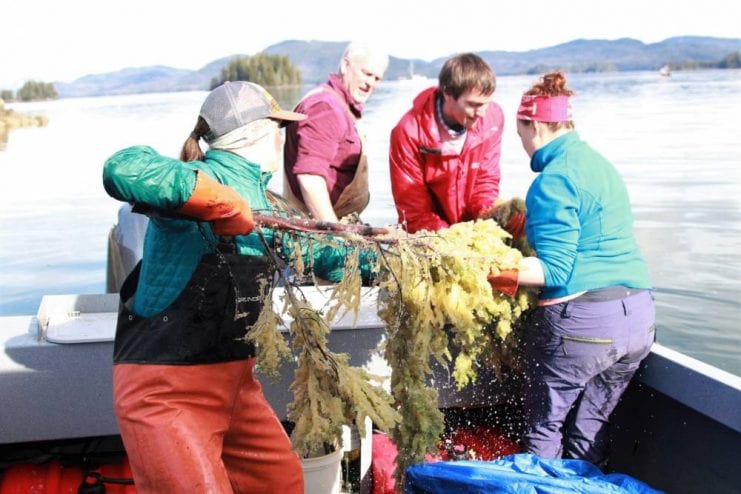
All hands are on deck at Sitka Tribe of Alaska when herring spawn. Every year, employees and volunteers from across a variety of departments drop their regular responsibilities to set hemlock branches and collect as many herring eggs as possible.
But that’s not the only thing the tribe is collecting this year. They’re also gathering genetic samples from herring and working with University of Washington researchers to uncover the code that dictates when and where herring spawn.
Jeff Feldpausch is head of STA’s Resource Protection Department. In the many years that he’s harvested for the tribe, he’s seen fewer and lesser quality herring eggs on the branches he pulls for awaiting elders.
“Another day of good spawn and they’d be really good eggs but it just kind of shut off,” he said on the deck of one STA boat. “It’s been kind of the nature of the subsistence fishery lately.”
Increasingly, that additional day of spawning just doesn’t come. The window of time when herring spawn has been shrinking over the years, Feldpausch said. That means less spawning and, in turn, less eggs on those branches.
“It used to be a lot better than this,” he said.

Feldpausch has been busy collecting herring eggs lately, but in another STA boat, fisheries biologist Kyle Rosendale is collecting genetic samples from the herring themselves.
While setting or collecting branches, Rosendale and other STA staff are on the lookout for spawning herring to catch and collect genetic samples from. One sample consists of about 50 clips of dorsal fins, each the size of a pinky nail.
The herring that’s caught ends up in a bait freezer to catch king salmon or halibut later in the year. The clips of dorsal fin are preserved in ethanol and mailed to researchers at the University of Washington who are studying herring populations from the Puget Sound to Sitka.
“What we’re trying to find is if there are distinct populations of herring,” Rosendale said. “It’d be the same species but different populations. And so, population A would only spawn with population A for the most part and population B would only spawn with population B for the most part.”
Rosendale says biologists don’t know much about the genetic makeup of herring that spawn in Sitka waters. Herring are more genetically diverse than we realize. The differences start between Atlantic and Pacific herring.
Originally from Europe, fisheries professor Lorenz Hauser from the University of Washington first took an interest in Atlantic herring. He said that by comparison, Pacific herring are quite differently ecologically.
“Atlantic herring spawn in deep waters so you can’t actually see it,” Hauser said. “Here, they’re more showy and because of that, people are really aware of population structure in herring and the different spawning sites.”
Spawning locations are not the only factor that may indicate a genetic difference. Eleni Petrou, a PhD student who works with Hauer, said fish that spawn during the main spawning season are genetically different to those that spawn in January or June.
“We found that spawn timing is actually related to genetic difference between those populations such that if a herring population spawns at one time of year, it’s different than one that spawns later or earlier,” she said.
That correlation between genetic diversity and spawn timing is so strong that if herring that spawn at a specific time disappear, it’s likely there’s been a loss in genetic diversity in the area, Petrou said.
If the diversity and spawn timing is ignored, humans can potentially impose selection on herring populations by only timing at certain times of year, Petrou said.
“That captures a certain subset of the population that returns to spawn at a given time, so that might lead to their over exploitation,” she said.

To conserve diversity in the genetic makeup of herring, management of fisheries should take spawn timing into higher consideration, just as much as spawning areas, Hauser said. That’s especially true in the assessment of herring stocks.
In addition to modern genetic samples, Petrou is also working on gathering archaeological samples from around the Puget Sound that could tell her what populations of herring ancient peoples relied on for food. By comparing DNA data found in ancient plates with samples gathered today, Petrou hopes to see which populations of herring are still in Pacific waters.
But what Hauer really wants to know is which populations have disappeared over the millenia.
“That’s really the interesting part,” he said. “We have heard about all these resident populations, also in Sitka, that didn’t leave the bay. And what we really want to do in the longer term is develop a method that allows us to look in the ancient DNA and see if we can find some populations that don’t exist anymore.”
Back on the STA boat, Jeff Feldpausch and many of the harvesters he knows are aware that there’s not as much spawn in Sitka waters as there once was.
“They’d go out and throw their branches in and there would be no problem getting eggs,” he said. “Now you have to be out there immediately when the spawn starts, get your branches in because it’s not a prolonged spawn.”
But, as this research may demonstrate, the problem might not just be fewer herring, but less genetic diversity, which has led to shorter spawning windows and fewer eggs in the freezers of Tlingit elders.






























